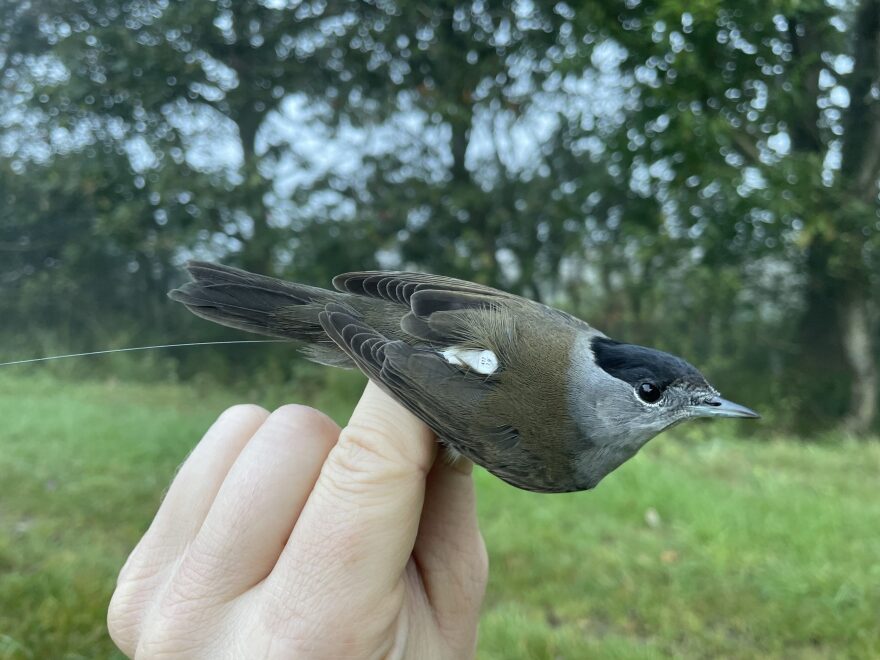As fall migration winds down, there are many ways to track where birds are going for the winter.
One of the newer methods being used in Wisconsin is called the Motus Wildlife Tracking System. It’s an international collaborative research network that uses small radio transmitters to track bird movement.
The transmitters are fitted onto birds like tiny backpacks. As a tagged bird flies within range of a receiver, a computer records the bird species, its location and how long it stays in that area. This data also becomes publicly accessible on the Motus website.
Jacob Woulf is the Motus Coordinator at the Lake Michigan Bird Observatory. He says more Motus stations are needed to adequately detect birds that travel through the state, since Wisconsin falls along a migration route called the Mississippi Flyway.
Lake Effect’s Xcaret Nuñez spoke with Woulf for this month’s Chirp Chat to learn how Motus works and what it can tell us about bird behavior.
This interview has been edited for length and clarity.
What is Motus, and what does the word mean?
The word Motus is derived from a Latin word meaning movement. Motus is a way that we can track migratory birds — not only migratory birds, but birds and other animals, too. People are familiar with songbird banding and GPS transmitters, but this is a completely different way that we can track birds.

Can you describe what a Motus station looks like and how the radio telemetry system works?
Motus stations typically have an array of antennas — ranging from three to five antennas — and each antenna is directional, meaning it's only listening for tags in the direction that it's facing. So anytime a bird carrying a specific transmitter flies by a station or within range of a station, the station will detect it, it'll log it, and then the Motus Wildlife Tracking System decodes that data, and then you'll be able to tell what bird actually flew by the station.
It's best to have as many [Motus stations] as possible. We have about two dozen in our network right now, and within the next couple of weeks, we'll be adding a couple more. And I say ‘as many as possible,’ because sometimes a bird could fly near a station and not get detected for whatever reason. But we're also considering it's impossible to cover the entire area with Motus stations, because from a practical standpoint, it's difficult, but also funding-wise, it's near impossible. So we try to make transects with these stations, invisible fences, if you will, to try to make it impossible for a tag bird to fly through and not get detected.
So far, we have a majority of Lake Michigan covered. That includes the main water body and Green Bay. We're also looking to build out two east-west transects that run from Lake Michigan to the Mississippi River. So we're in the process of installing stations, looking for partners along those lines and then working everything out to establish stations there.

Tagging birds with a Motus device can help us track a bird's migration pattern. But how is this different from traditional tracking methods like bird banding?
Bird banding has been used for a really long time, probably hundreds of years. And the problem with bird banding is that it requires you to recapture the bird. So if we captured a bird right here, put a band on it and sent it on its way, for you to tell where that bird was tagged or where it's been, it has to be recaptured again. Which happens a lot, because there are a lot of people who still band birds. And I'm not saying that it's not important to band birds and that you can't get anything from them — but with the Motus Wildlife Tracking System, you don't need to recapture that bird. As long as it flies within range of a station and that station detects it, you can see every single other station that that bird has flown by. You can know right away where it was tagged and other information that was collected when the bird was tagged. So, [compared to bird banding], you only need to capture birds once to get potentially a lot of information.
Whether or not you're banding birds or tagging birds, a project with special permissions is needed. For example, say you're a bander, you can't just go out and say, ‘Oh, I'm gonna put some Motus tags on some Bluebirds today and some Robins tomorrow.' You have to have a really specific project and really specific questions that you're looking to answer by tagging these birds. So it's pretty strict requirements. And along with that, the people applying the tags have to have special training. They have to really know what they're doing to apply these tags to the birds. I will say, though, that bird banding — putting a band on the leg of a bird — is required before any transmitter, whether it's Motus or GPS, is applied.

What can researchers or the average birder learn from the data that Motus collects?
So next year, [Lake Michigan Bird Observatory] is starting a multi-year Purple Martin tagging project. Purple Martin is a species of special concern in Wisconsin. They solely rely on human-made houses to survive in this part of North America. They used to be primarily cavity nesters, but with the decline of cavities, like dead trees, they've relied solely on these human-made nest boxes.
So we're very curious to learn about Purple Martin site fidelity, which just means: Is the individual staying at the site? How long are they staying at the site? Are they tied to it? Are they coming back year after year? Purple Martins also have this interesting habit of forming very large roosting flocks before fall migration, and one is located up by Lake Poygan in the Lake Winnebago system. We'd be interested in knowing if the birds that are tagged down here are flying all the way up there, and how many birds in this general area are using this roost site. The roost site is important because it's relatively small and it's been used for a very long time, and if something were to happen to this roost site, that would be very devastating, potentially, to the population. So by using Motus technology, we can identify important areas that birds utilize, whether it's stopover sites, roosting sites or important migration corridors, to inform land managers and the public, which would impact birds in a good way.
To learn more about the Motus tracking method, visit the Motus Wildlife Tracking System and the Lake Michigan Bird Observatory’s website.
Chirp Chat’s Bird of the Month for October

“Ruffed Grouse are primarily a ground species, so they'll forage on the ground, and typically only fly when they go to roost, or if they're frightened,” Woulf says. “They have a crest that’s generally brown, but some have slightly different color morphs that are reddish or a little more gray. But it looks like a stocky chicken — a bird that's smaller than a chicken. The males are known for this very neat mating ritual, known as drumming. It's a display used to attract females, where they will stand on a log and beat their wings. It's a beat that starts very slowly and ends very fast. It's similar to the sound of pulling on the cord of a lawnmower, but then the drumming just all of a sudden stops."







